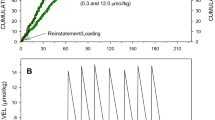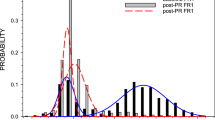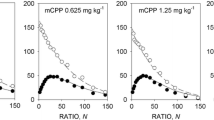Abstract
Male Wistar rats were trained to press a lever with food reinforcement according to a continuously reinforced schedule (CRF). Afterwards, rats were subjected to three experimental sessions (30 min each) during which responding was rewarded according to a progressive ratio schedule (following an initial 2-min CRF period, the number of presses necessary for the pellet delivery was doubled every second minute). Responding during the first half of each session, i.e., pressing for food, was maintained at a significant level, whereas it was almost suppressed during the second part of the session. As compared to controls (200±20 presses/30 min) animals given amfonelic acid (0.5, 1 mg/kg IP), methylphenidate (4, 8 mg/kg IP), caffeine (16 mg/kg IP), cocaine (4 mg/kg IP), oxolinic acid (32 mg/kg IP), nomifensine (4 mg/kg IP), DR 250 (2, 4 mg/kg IP) and d-amphetamine (0.25, 0.5, 1 mg/kg IP) showed an increased rate of responding ranging from 400 to 950 presses/30 min. In contrast, apomorphine, MK 486+l-dopa, trihexyphenidyl, imipramine, salbutamol and diazepam did not increase responding. These results suggested that this test is highly sensitive for psychomotor stimulants and perhaps for their ability to enhance the reinforcing value of the reward or stimuli associated with the reward. Such activity seemed related to a catecholaminergic substrate since the increase of responding induced by amphetamine was blocked by pimozide, d,l-propranolol and prazosin.
Similar content being viewed by others
References
Axiotis S, Dreux J, Sollier JC, Chermat R, Poncelet M, Simon P (1981) Tetrahydropyrones-2. I-Synthèses et activité pharmacologique. Eur J Med Chem — Chimica Therapeutica 16:431–438
Beninger RJ, Hanson DR, Phillips AG (1981) The acquisition of responding with conditioned reinforcement: Effects of cocaine, (+)-amphetamine and pipradrol. Br J Pharmacol 74:149–154
Chermat R, Kloczko J, Warot D, Simon P (1979) Effets psychoanaleptiques de l'acide oxolinique. J Pharmacol (Paris) 10:145–157
Dantzer R (1976) Effect of diazepam on performance of pigs in a progressive ratio-schedule. Physiol Behav 17:161–163
Dews PB, Wenger GR (1977) Rate-dependency of the behavioral effects of amphetamine. In: Thompson T, Dews PB (eds) Advances in behavioral pharmacology, vol. 1. Academic, New York, pp 167–227
Dudderidge HJ, Gray JA (1975) Joint effects of sodium amylobarbitone and amphetamine sulfate on resistance to extinction of a rewarded running response in the rat. Psychopharmacologia 44:83–85
Francès H, Puech AJ, Chermat R, Simon P (1979) Are psychopharmacological effects of beta-adrenergic stimulants central or peripheral? Pharmacol Res Commun 11:273–278
Garattini S, Samanin R (1981) The pharmacological profile of some psychomotor stimulant drugs including chemical, neurophysiological, biochemical and toxicological aspects. In: Hoffmeister F, Stille G (eds) Handbook of experimental pharmacology, vol 55, 2nd ed: Psychotropic agents. Springer, Berlin Heidelberg New York, pp 545–586
Gray JA (1977) Drug effects of fear and frustration: Possible limbic site of action of minor tranquilizers. In: Inversen L, Iversen S, Snyder S (eds) Handbook of psychopharmacology, section 2: Behavioural pharmacology in animals. Plenum, New York, pp 433–527
Hill RT (1970) Facilitation of conditioned reinforcement as a mechanism of psychomotor stimulation. In: Costa A, Garattini S (eds) Amphetamines and related compounds. Raven, New York, pp 781–794
Hoffmann J (1973) 8-amino-2-methyl-1, 2, 3, 4-tetrahydroisoquinoline, a new antidepressant. Arzneim Forsch 23:45–50
Katz JL (1982) Rate dependent effects of d- and l-amphetamine on schedule-controlled responding in pigeons and squirrel monkeys. Neuropharmacology 21:235–242
Levine TE, McGuire PS, Heffner TG, Seiden LS (1980) DRL performance in 6-hydroxydopamine-treated rats. Pharmacol Biochem Behav 12:287–291
Miczek KA (1973) Effects of scopolamine, amphetamine and benzodiazepines on conditioned suppression. Pharmacol Biochem Behav 1:401–411
Miller HH, Shore PA (1982) Effects of amphetamine and amfonelic acid on the disposition of striatal newly synthesized dopamine. Eur J Pharmacol 78:33–44
Porsolt RD, Bertin A, Jalfre M (1977) Behavioural despair in mice: A primary screening test for antidepressants. Arch Int Pharmacodyn Ther 229:327–336
Porsolt RD, Bertin A, Blavert N, Deniel M, Jalfre M (1979) Immobility induced by forced swimming in rats: Effects of agents which modify central catecholamine and serotonin activity. Eur J Pharmacol 57:201–210
Puech AJ, Chermat R, Poncelet M, Doaré L, Simon P (1981) Antagonism of hypothermia and behavioral response to apomorphine: A simple, rapid and discriminating test for screening antidepressants and neuroleptics. Psychopharmacology 75:84–91
Ridley RM, Baker HF, Haystead TAJ (1981) Perseverative behaviour after amphetamine; dissociation of response tendency from reward association. Psychopharmacology 75:283–286
Robbins TW (1976) Relationship between reward-enhancing and stereotypical effects of psychomotor stimulant drugs. Nature 264:57–59
Robbins TW (1978) The acquisition of responding with conditioned reinforcement: Effect of pipradrol, methylphenidate, d-amphetamine and nomifensine. Psychopharmacology 58:79–87
Sanger DJ (1980) The effects of caffeine on timing behaviour in rodents: Comparisons with chlordiazepoxide. Psychopharmacology 68:305–309
Simon P, Chermat R, Fosset MT, Boissier JR (1972) Inhibiteurs beta-adrenergiques et stereotypies provoquées par l'amphétamine ou l'apomorphine chez la rat. Psychopharmacologia 23:357–364
Simon P (1978) Testing psychostimulants in animals. In: Deniker P, Radouco-Thomas C, Villeneuve A (eds) Neuropsychopharmacology. Pergamon, Oxford, pp 209–214
Spencer PSJ (1977) Review of the pharmacology of existing antidepressants. Br J Clin Pharmacol 4 (Suppl 2):57S-68S
Thompson DM (1972) Enhancement of progressive ratio performance by chlordiazepoxide and phenobarbital. J Exp Anal Behav 17:287–292
Weiss B, Laties VG (1971) Reconciling the effects of amphetamine on human and animal behaviour. In: de Baker SD (ed) The correlation of adverse effects in man with observations in animals. Excerpta Medica Int Cong, series 220, Amsterdam, pp 32–36
Wise RA, Spindler J, de Wit M, Gerber GJ (1978) Neuroleptic-induced anhedonia in rats: Pimozide blocks reward quality of food. Science 201:262–264
Author information
Authors and Affiliations
Rights and permissions
About this article
Cite this article
Poncelet, M., Chermat, R., Soubrie, P. et al. The progressive ratio schedule as a model for studying the psychomotor stimulant activity of drugs in the rat. Psychopharmacology 80, 184–189 (1983). https://doi.org/10.1007/BF00427967
Received:
Accepted:
Issue Date:
DOI: https://doi.org/10.1007/BF00427967




